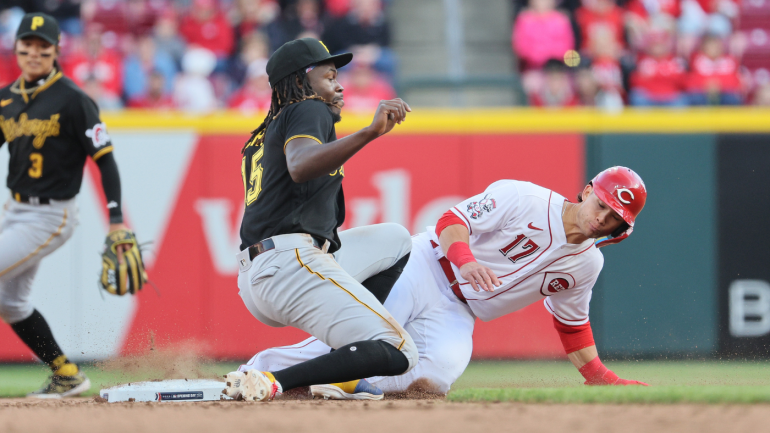
Major League Baseball kicked off the 2023 regular season on Thursday with a full 15-game set. Players and fans across the league, then, were introduced for the first time to MLB's newest set of rules in a meaningful setting. If you haven't been paying attention over the offseason, or even during spring training, the main new rules to be aware of are:
- A pitch timer that necessitates pitchers start their deliveries within 15 seconds with the bases empty, and within 20 seconds with someone on board;
- Defensive positioning restrictions that require two infielders on each side of the second-base bag, with their feet placed within the infield border;
- And larger bases that measure 18 square inches instead of 15.
MLB and the MLB Players Association agreed to these changes with the hope that they would improve the pace of play and incentivize more batted balls and stolen-base attempts -- or, in other words, more action. How did everyone deal with the new rules on Opening Day 2023? While acknowledging the small sample size, let's take a look at the numbers with a focus on how the rules impacted the time of game and stolen-base attempts across the league, as well as the violations that were incurred.
Average length of game was down, stolen base attempts up
The two main metrics on everyone's radar coming into Thursday were how long would games last and how many stolen bases would teams attempt. We're here to tell you that both measures moved in the intended directions.
The average length of the 15 games was two hours and 45 minutes. For reference, last season's average game lasted three hours and three minutes. In other words, Opening Day bouts were about 18 minutes shorter than the typical contest was in 2022. The range included the Blue Jays-Cardinals marathon (relatively anyway) that lasted more than three hours and 30 minutes, as well as a Tigers-Rays sprint that lasted two hours and 14 minutes.
As for stolen bases, teams went 21 for 23 on those. That works out to 1.53 attempts per game. Last season, teams attempted 0.67 stolen bases per game. If the first day of the year was any indication, teams are going to be far more aggressive thanks to the bigger bases and the limited number of "disengagement" that pitchers are afforded per plate appearance..
Lastly, we'll note that there were 14 pitch-timer violations. Nine were recorded by pitchers or fielders, five by hitters.
Devers had most consequential violation
The most notable -- not the oddest, that's still to come -- violation belonged to Red Sox third baseman Rafael Devers. He was called out on strikes in the eighth inning without seeing an official third strike:
Watch as Rafael Devers becomes the first player in MLB history to be called out because of a pitch clock violation. 😐
— Codify (@CodifyBaseball) March 30, 2023
There's just not enough time to safely step out between pitches (even foul balls). pic.twitter.com/owm6v86aHJ
The rules stipulate that batters must "engage" the pitcher -- meaning, in other words, look at them and be ready to hit -- before the eight-second mark. Devers was not ready to hit, and so he ended up losing a chance for one more swing.
The Red Sox, who lost by a run to the Orioles, would end up plating three other runs that inning. Who knows how things play out if Devers had simply followed the new rules.
Mets committed oddest violation
In our opinion, anyway, the weirdest violation on Thursday involved Mets teammates Pete Alonso and Jeff McNeil, as well as home plate umpire Larry Vanover. The long story made short is that Vanover charged McNeil with a strike after Alonso took too long to return to first base following a foul ball in the sixth inning of New York's game against the Marlins. Take a look:
Jeff McNeil was given a strike by the plate umpire after Pete Alonso took too long getting back to first base pic.twitter.com/GbEb8ch6gD
— SNY (@SNYtv) March 30, 2023
The call put McNeil in an 0-2 hole against Sandy Alcantara after seeing just one pitch. Nevertheless, he was able to work a 1-2 count before notching a single that plated a run.
Alonso, and everyone else who found the rules a little overwhelming on Thursday, will just have to make the necessary adjustments over the coming days.






















